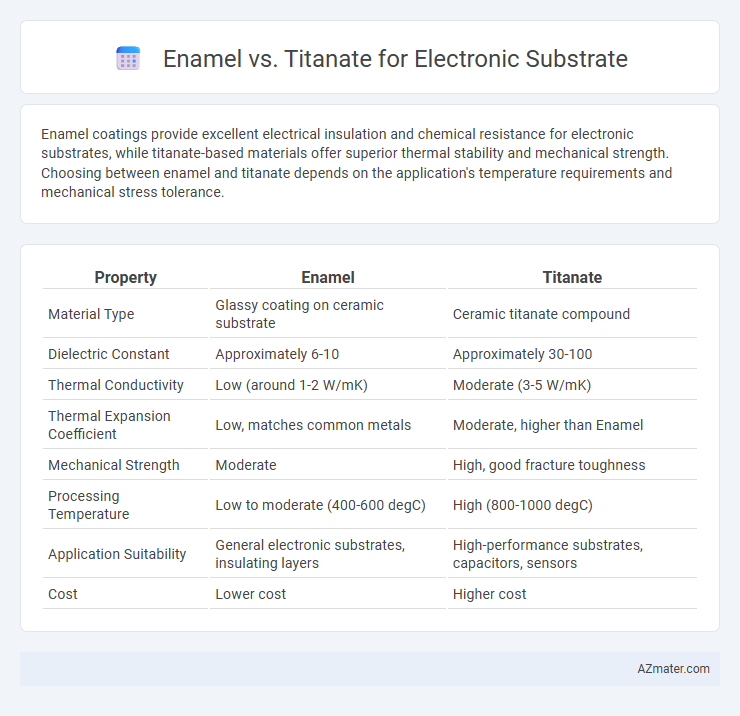Enamel coatings provide excellent electrical insulation and chemical resistance for electronic substrates, while titanate-based materials offer superior thermal stability and mechanical strength. Choosing between enamel and titanate depends on the application's temperature requirements and mechanical stress tolerance.
Table of Comparison
| Property | Enamel | Titanate |
|---|---|---|
| Material Type | Glassy coating on ceramic substrate | Ceramic titanate compound |
| Dielectric Constant | Approximately 6-10 | Approximately 30-100 |
| Thermal Conductivity | Low (around 1-2 W/mK) | Moderate (3-5 W/mK) |
| Thermal Expansion Coefficient | Low, matches common metals | Moderate, higher than Enamel |
| Mechanical Strength | Moderate | High, good fracture toughness |
| Processing Temperature | Low to moderate (400-600 degC) | High (800-1000 degC) |
| Application Suitability | General electronic substrates, insulating layers | High-performance substrates, capacitors, sensors |
| Cost | Lower cost | Higher cost |
Introduction to Electronic Substrates
Electronic substrates serve as foundational platforms for mounting and interconnecting semiconductor devices, impacting performance and reliability. Enamel coatings provide excellent insulation and corrosion resistance, ideal for low-frequency applications, while titanate substrates offer superior thermal conductivity and mechanical strength, supporting high-power and high-frequency circuits. Selecting between enamel and titanate depends on specific requirements such as thermal management, electrical insulation, and mechanical stability in electronic packaging.
Overview of Enamel as an Electronic Substrate
Enamel as an electronic substrate provides excellent dielectric properties, high thermal stability, and strong adhesion to metal surfaces, making it suitable for insulated coatings on electronic components. It offers resistance to moisture, chemical corrosion, and electrical breakdown, which enhances the longevity and reliability of electronic circuits. Enamel substrates are widely used in applications requiring insulation layers in transformers, inductors, and coils due to their cost-effectiveness and robust performance.
Overview of Titanate as an Electronic Substrate
Titanate ceramics, such as barium titanate, offer exceptional dielectric properties, high thermal stability, and excellent insulation capabilities, making them ideal for electronic substrates. Their tunable dielectric constant and low dielectric loss contribute to improved signal integrity in high-frequency applications. The material's compatibility with thick-film technology enhances its use in multilayer ceramic capacitors and integrated circuit packaging.
Material Properties: Enamel vs Titanate
Enamel substrates offer excellent electrical insulation and chemical resistance but typically have lower thermal conductivity and mechanical strength compared to titanate-based materials. Titanate substrates exhibit superior dielectric properties, higher thermal stability, and enhanced mechanical durability, making them more suitable for high-frequency and high-temperature electronic applications. The choice between enamel and titanate depends on balancing insulation requirements and thermal management in electronic device design.
Dielectric Performance Comparison
Enamel and titanate materials exhibit distinct dielectric properties that impact electronic substrate performance, with titanate generally offering higher dielectric constants, typically exceeding 100, compared to enamel's lower range around 5-10. Titanate substrates provide superior capacitance and lower dielectric loss, enhancing signal integrity and reducing energy dissipation in high-frequency applications. Enamel substrates, while easier to process and cost-effective, demonstrate limited dielectric strength and thermal stability compared to titanate ceramics, making titanate preferable for advanced electronic substrates requiring robust dielectric performance.
Thermal Stability and Conductivity
Enamel substrates exhibit moderate thermal stability with thermal expansion coefficients typically around 7-9 ppm/degC, but they often suffer from lower thermal conductivity, generally below 1.5 W/m*K, which limits heat dissipation in high-power electronics. Titanate-based substrates, such as those using barium titanate ceramics, provide enhanced thermal stability with expansion coefficients closely matched to silicon (~3 ppm/degC) and higher thermal conductivity values ranging between 2 to 5 W/m*K, enabling improved thermal management in electronic devices. The superior thermal compatibility and conductivity of titanate materials make them preferable for high-performance electronic substrates requiring efficient heat dissipation and dimensional stability under thermal cycling.
Mechanical Strength and Durability
Titanate substrates exhibit superior mechanical strength compared to enamel due to their higher fracture toughness and resistance to thermal shock, making them ideal for high-stress electronic applications. Enamel coatings, while providing excellent insulation and corrosion resistance, generally possess lower mechanical robustness and are prone to cracking under mechanical strain. The enhanced durability of titanate substrates ensures longer lifespan and reliability in electronic devices subjected to rigorous operational conditions.
Manufacturing Processes and Scalability
Enamel coatings on electronic substrates offer ease of application through conventional dipping or spraying techniques, enabling quick curing cycles suited for large-scale production. Titanate-based substrates require advanced deposition methods such as sol-gel or chemical vapor deposition, which demand precise control and longer processing times, impacting throughput. Scalability favors enamel processes for cost-effective mass manufacturing, while titanate substrates provide superior performance with higher complexity and investment in production infrastructure.
Cost Analysis: Enamel vs Titanate
Enamel substrates exhibit lower material and manufacturing costs compared to titanate substrates, primarily due to simpler processing techniques and abundant raw materials. Titanate substrates, while offering superior dielectric properties and thermal stability, incur higher expenses from complex synthesis and sintering processes. Cost analysis reveals enamel substrates as cost-effective for standard electronic applications, whereas titanate substrates justify their premium pricing in high-performance or specialized environments.
Application Suitability and Industry Adoption
Enamel coatings on electronic substrates provide excellent insulation and corrosion resistance, making them suitable for applications requiring robust moisture protection and electrical insulation in consumer electronics and automotive industries. Titanate coatings offer superior thermal stability and mechanical strength, which enhances performance in high-frequency and high-power electronic applications such as aerospace and industrial machinery. Industry adoption favors enamel for cost-effective, versatile uses, while titanate gains traction in advanced sectors demanding higher durability and thermal management.

Infographic: Enamel vs Titanate for Electronic Substrate
 azmater.com
azmater.com